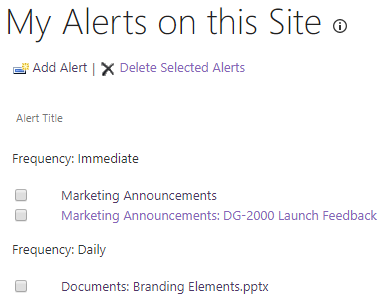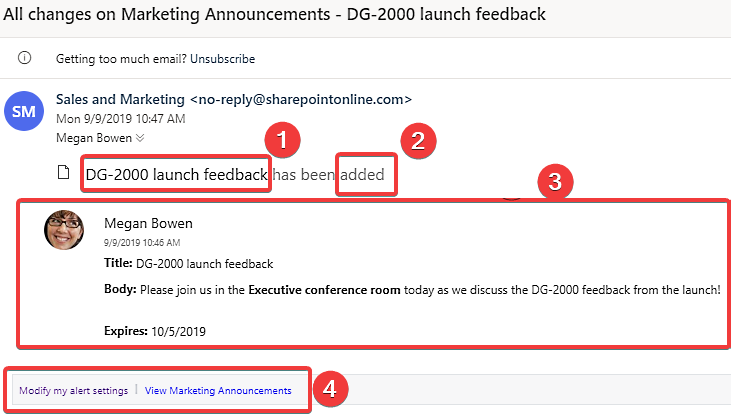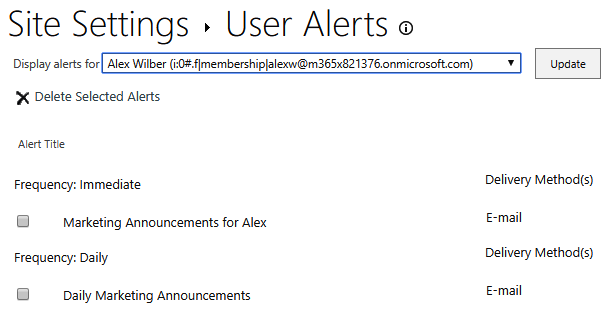- Microsoft 365 and SharePoint Online Cookbook
- Gaurav Mahajan;Sudeep Ghatak
- 1009字
- 2021-04-02 20:25:29
Adding alerts
SharePoint notifies you by email when items are added, edited, or deleted in lists or libraries.
In this recipe, we will see how to create email alerts for SharePoint lists and libraries.
Getting ready
You will need at least Readaccess on the list or library for which you'd like to get alerted.
How to do it...
Browse to the list for which you would like to view or change the settings.
Click Alert me,as shown in the following screenshot:

This shows the Alert me dialog box. Here, you can specify various properties and settings for the alert to be created:
Alert Title: Specify a title for the alert that is descriptive of what the alert is for. The title will be shown in the subject line of the email alert that the selected users will receive.
Send Alerts To: Users with Full Control access to the list, such as the list owners, see this additional option. This option enables you to subscribe other users to receive these alerts. Note that only users that have at least Read access to the list will be able to receive alerts from it.
Delivery Method: The alert delivery method defaults to email. Note that even though the screen shows a Text message (SMS) option, that option is no longer enabled for SharePoint Online (at least, at the time of writing).
Change Type: This is where you can specify what kind of change triggers the alert—that is, would you like to get alerted if anything changes in that list or would you like to get alerted only if items are either added, modified, or deleted?
Send Alerts for These Changes: This lets you specify filters for when you would want to get alerted. You can select to be alerted when anything changes or when items that you have created or modified have changed. You can also restrict your alerts to trigger only when items in a particular view are changed by someone.
When to Send Alerts: This final option lets you select the alert frequency. You can choose to receive an immediate alert or schedule a daily or weekly summary alert. If you opt to receive a daily or weekly summary alert, you can also choose the time at which you receive the summary notification email.
How it works...
Alerts in SharePoint are a very handy way to get notified about changes in a list or library. Announcements, Contacts, Issue Tracking/ Tasks lists, and Calendar are examples of where you might want to get notified of such changes. In addition to setting up alerts on entire lists and libraries, SharePoint also lets you set alerts on individual list items and/or documents, as shown in the following screenshot:

This can be handy when, for example, you are collaborating with your team on important documents and would like to stay up to date on any changes made to them.
Once you've created a list- or item-level alert, you can modify and/or delete it through the Manage my alerts menu option, as shown in the following screenshot:

Clicking Manage my alerts will take you to the following screen, which will show you your alerts for all the lists, libraries, items, and documents across the entire site:
 .
.
Clicking the alert name will enable you to make changes to it. Selecting one or more alert(s) and clicking Delete Selected Alerts will delete the alert(s). Note that unlike various other information types in SharePoint, deleted alerts don't go to the recycle bin, and hence cannot be recovered.
There's more...
When you sign up for alerts in SharePoint, you receive detailed email notifications every time that the alert is triggered. These emails contain various details about the item itself and metadata surrounding the triggering event. In the next section, we will look at these emails in more detail. We will then see how, as a site administrator, you can view and manage alerts that other site users may have subscribed to.
Notification emails
SharePoint sends two types of emails for alerts:
An email notifying you that the alert has successfully been created: When you sign up for alerts on a list or library, SharePoint sends a confirmation email letting you know that an alert has been created. The following screenshot shows an example of such an email:

As you can see from the preceding example, the notification email contains the following information:
The name of the list or library that the alert is for
A link to the site that contains the list or library
A link to the view/manage alerts page that we discussed in the preceding section
The actual alert email: SharePoint sends an alert email when an activity occurs that matches your specified criteria. The following screenshot shows an example of an alert notification email:

As you can see from the preceding example, the notification email contains the following information:
Name of the item that the alert is for—the name hyperlinks to the corresponding item in the list
The type of change that triggered the alert
Details of the item, including who triggered the action and when
A hyperlink to modify the alert settings
A hyperlink to view the corresponding list
Finding and deleting other users' alerts
As a site administrator, you can not only view and manage your alerts but you can also view and delete alerts for other users of your site. To do so, browse to the Site Settings page of your site, as described in the Viewing and changing site settings recipe inChapter 3, Working with Modern Sites in SharePoint Online. Then, click User Alertsunder the Site Administrationheading. This will take you to the User Alertspage, as shown in the following screenshot:

Here, you can select a user from the Display alerts for drop-down option, and click Update to view alerts that they are subscribed to. You can then select appropriate alerts and delete them by clickingDelete Selected Alerts.
See also
The Viewing and changing site settings recipe, Chapter 3, Working with Modern Sites in SharePoint Online
- 程序員修煉之道:程序設計入門30講
- 編程的修煉
- Instant Apache Stanbol
- Debian 7:System Administration Best Practices
- Mastering JBoss Enterprise Application Platform 7
- 零基礎學單片機C語言程序設計
- Go語言精進之路:從新手到高手的編程思想、方法和技巧(2)
- SQL 經典實例
- 好好學Java:從零基礎到項目實戰
- Hands-On Kubernetes on Windows
- Instant Automapper
- Three.js權威指南:在網頁上創建3D圖形和動畫的方法與實踐(原書第4版)
- C語言程序設計實驗指導
- MySQL從入門到精通
- 多接入邊緣計算實戰